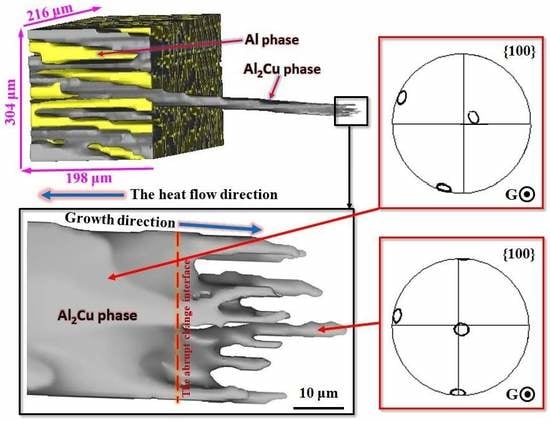Orientation and Microstructure Evolution of Al-Al2Cu Regular Eutectic Lamellar Bifurcating in an Abruptly Changing Velocity under Directional Solidification
Abstract
1. Introduction
2. Experimental Procedures
2.1. Materials
2.2. Characterization
3. Results and Discussions
4. Conclusions
- (1)
- After the abruptly changing interface, Al-Al2Cu eutectic lamellar spacing decreased. Al2Cu phase was bifurcated to form the new lamellar to refine in the three-dimensional microstructures.
- (2)
- The growth orientation of eutectic Al2Cu phase also grew along its (001) direction near the heat flow. The deviation angle between growth orientation of eutectic Al2Cu phase and the heat flow direction was decreased after the abruptly changing interface by micro-orientation analysis methods.
- (3)
- A brief description about the spacing adjustment mechanism of eutectic lamellar forking was given. The eutectic lamellar refined was due to the hindrance of the lateral solute diffusion after the interface instability, and the solid-liquid interface of eutectic mainly moved along the heat flow direction.
Author Contributions
Funding
Acknowledgments
Conflicts of Interest
Data Availability
References
- Guo, C.; Wang, J.; Li, J.; Wang, Z.; Huang, Y.; Gu, J.; Lin, X. Coupling eutectic nucleation mechanism investigated by phase field crystal model. Acta Mater. 2018, 145, 175–185. [Google Scholar] [CrossRef]
- Hou, N.; Belyakov, S.; Pay, L.; Sugiyama, A.; Yasuda, H.; Gourlay, C.M. Competition between stable and metastable eutectic growth in Sn-Ni alloys. Acta Mater. 2018, 149, 119–131. [Google Scholar] [CrossRef]
- Senninger, O.; Peters, M.; Voorhees, P.W. Two-Phase Eutectic Growth in Al-Cu and Al-Cu-Ag. Met. Mater. Trans. A 2018, 49, 1692–1707. [Google Scholar] [CrossRef]
- Chen, L.; Liu, Z.; Wang, B.; Song, Q.; Wan, Y.; Chen, L. Surface Characterization and Tribological Performance of Anodizing Micro-Textured Aluminum-Silicon Alloys. Mater. 2019, 12, 1862. [Google Scholar] [CrossRef] [PubMed]
- Zhu, Q.; Zhang, B.; Zhao, X.; Wang, B. Binary Additives Enhance Micro Arc Oxidation Coating on 6061Al Alloy with Improved Anti-Corrosion Property. Coatings 2020, 10, 128. [Google Scholar] [CrossRef]
- Xu, D.; Chen, K.; Chen, Y.; Chen, S. Evolution of the Second-Phase Particles and Their Effect on Tensile Fracture Behavior of 2219 Al-xCu Alloys. Met. 2020, 10, 197. [Google Scholar]
- Çadırlı, E.; Kaya, H.; Gündüz, M. Effect of growth rates and temperature gradients on the lamellar spacing and the undercooling in the directionally solidified Pb–Cd eutectic alloy. Mater. Res. Bull. 2003, 38, 1457–1476. [Google Scholar] [CrossRef]
- Meng, G.H.; Lin, X.; Huang, W.D. Lamellar Spacing Selection in Regular Eutectic Solidification at Low Velocity. J. Mater. Sci. Technol. 2007, 23, 851–854. [Google Scholar]
- Jackson, K.; Hunt, J. Lamellar and Rod Eutectic Growth. Dynamics of Curved Fronts 1988, 4, 363–376. [Google Scholar]
- Cline, H.E. Theory of lamellar dendrite transition in eutectic alloys. Trans. Metall. Soc. AIME 1968, 242, 1613–1618. [Google Scholar]
- Cline, H.E. Stability of lamellar eutectics. J. Appl. Phys. 1979, 50, 4780. [Google Scholar] [CrossRef]
- Cline, H. Growth of eutectic alloy thin films. Mater. Sci. Eng. 1984, 65, 93–100. [Google Scholar] [CrossRef]
- Strassler, S.; Schneider, W.R. Schneider, Proceedings of the international conference on low temperature physics. Phys. cond. Matter 1974, 17, 153–160. [Google Scholar]
- Mollard, F.R. Growth of composites from the melt-part I. Trans. Metall. Soc. 1967, 239, 1526–1533. [Google Scholar]
- Mollard, F.R. Growth of composites from the melt-part II. Trans. Metall. Soc. 1967, 239, 1534–1546. [Google Scholar]
- Trivedi, R.; Mason, J.T.; Verhoeven, J.D.; Kurz, W. Eutectic spacing selection in lead-based alloy systems. Met. Mater. Trans. A 1991, 22, 2523–2533. [Google Scholar] [CrossRef]
- Double, D. Imperfections in lamellar eutectic crystals. Mater. Sci. Eng. 1973, 11, 325–335. [Google Scholar] [CrossRef]
- Kraft, R.W.; Albright, D.L. Microstructure of unidirectionally solidified Al-Al2Cu eutectic. Trans. Metall. Soc. AIME 1961, 221, 95–102. [Google Scholar]
- Zhu, W.; Ren, Z.; Ren, W.-L.; Zhong, Y.B.; Deng, K. Effects of high magnetic field on the unidirectionally solidified Al–Al2Cu eutectic crystal orientations and the induced microstructures. Mater. Sci. Eng. A 2006, 441, 181–186. [Google Scholar] [CrossRef]
- Li, X.; Fautrelle, Y.; Moreau, R.; Ren, Z. EBSD study of the morphology and orientation of the primary and eutectic phases in Al–Cu alloys during solidification under a strong magnetic field. J. Appl. Crystallogr. 2016, 49, 139–148. [Google Scholar] [CrossRef]
- Belgacem, C.H.; Fnaiech, M.; Loubradou, M.; Lay, S.; Bonnet, R. HRTEM Observation of a 〈113〉θ Low Angle Tilt Boundary in the Al-Al2Cu(θ) Eutectic Composite. Phys. Status solidi A 2002, 189, 183–196. [Google Scholar] [CrossRef]
- Gao, K.; Li, S.; Xu, L.; Fu, H. Effect of sample size on intermetallic Al2Cu microstructure and orientation evolution during directional solidification. J. Cryst. Growth 2014, 394, 89–96. [Google Scholar] [CrossRef]
- Sidhu, R.; Chawla, N. Three-dimensional microstructure characterization of Ag3Sn intermetallics in Sn-rich solder by serial sectioning. Mater. Charact. 2004, 52, 225–230. [Google Scholar] [CrossRef]
- Lieberman, S.; Gokhale, A.; Tamirisakandala, S. Reconstruction of three-dimensional microstructures of TiB phase in a powder metallurgy titanium alloy using montage serial sectioning. Scr. Mater. 2006, 55, 63–68. [Google Scholar] [CrossRef]
- Gao, K.; Li, S.; Xu, L.; Fu, H. Effect of solidification rate on microstructures and orientations of Al-Cu hypereutectic alloy in thin crucible. Cryst. Res. Technol. 2014, 49, 164–170. [Google Scholar] [CrossRef]
- Tegze, G.; Toth, G. Osmotic convection-driven instability and cellular eutectic growth in binary systems. Acta Mater. 2012, 60, 1689–1694. [Google Scholar] [CrossRef]
- Xu, J.-J.; Chen, Y.-Q.; Li, X.M. Global instabilities of lamellar eutectic growth in directional solidification. J. Cryst. Growth 2014, 401, 99–105. [Google Scholar] [CrossRef]
- Meng, G.H.; Lin, X.; Huang, W.D. Lamellar eutectic growth controlled by solute diffusion. Acta. Metall. Sin. 2007, 43, 1176–1180. [Google Scholar]
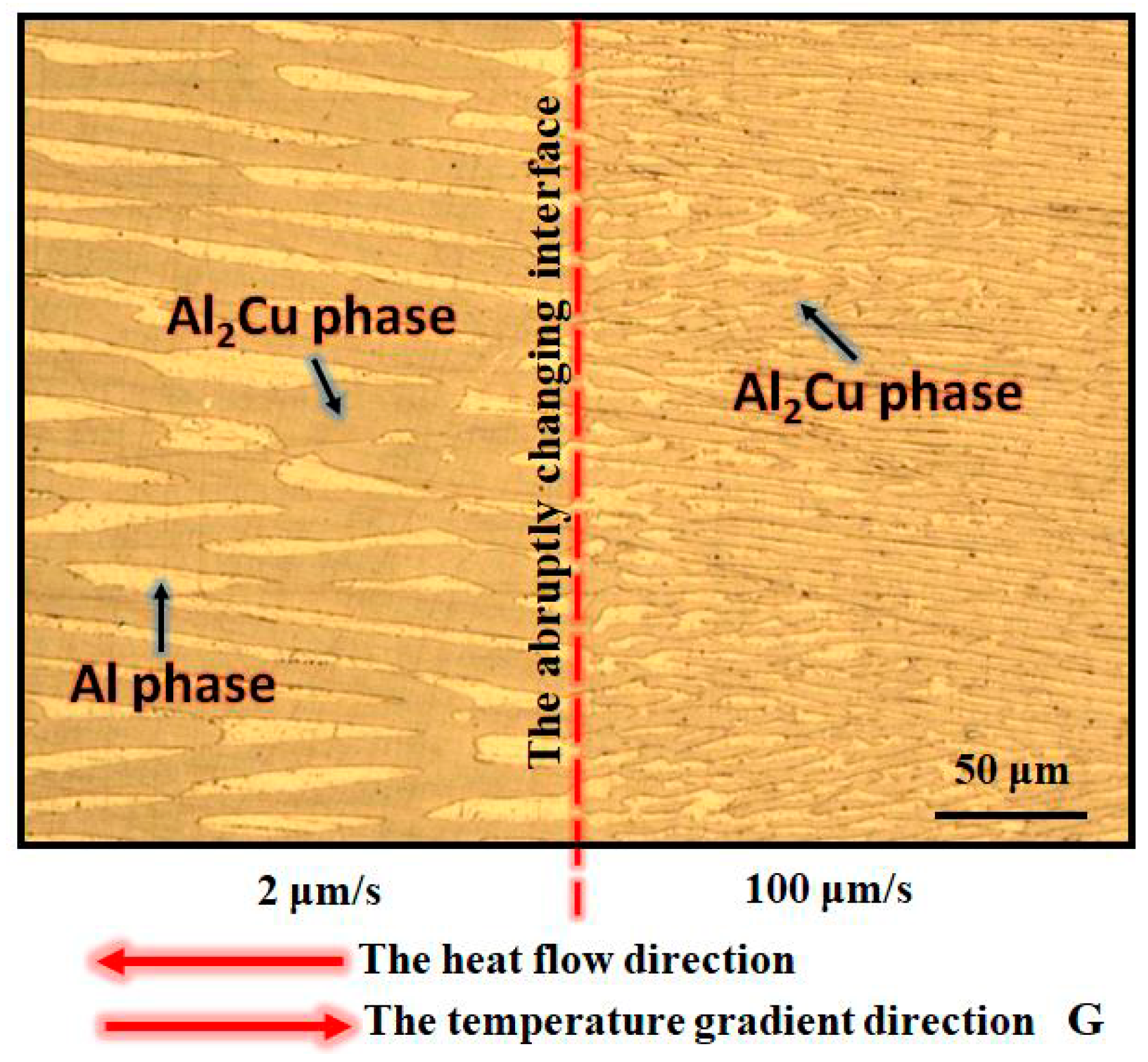
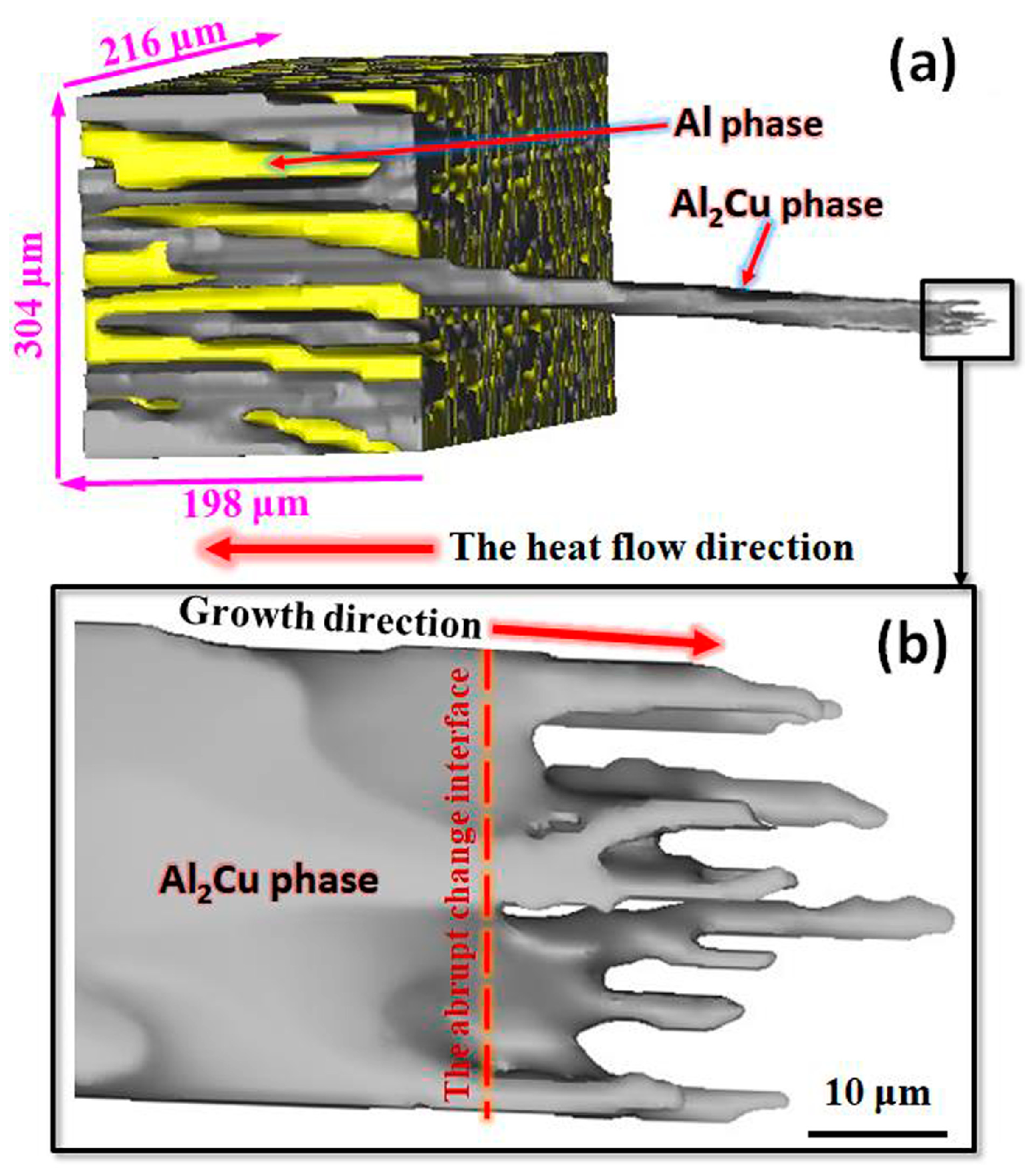
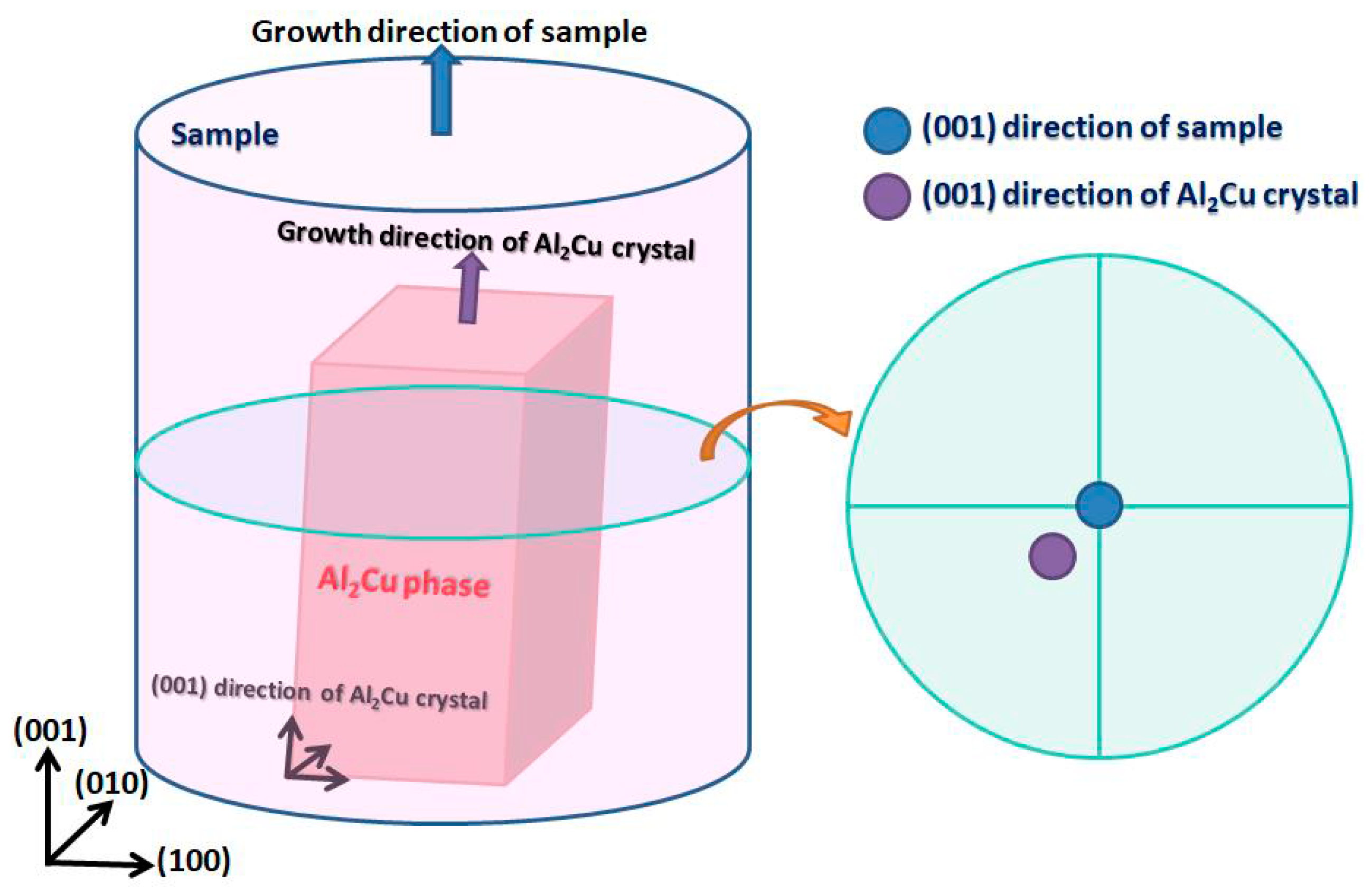

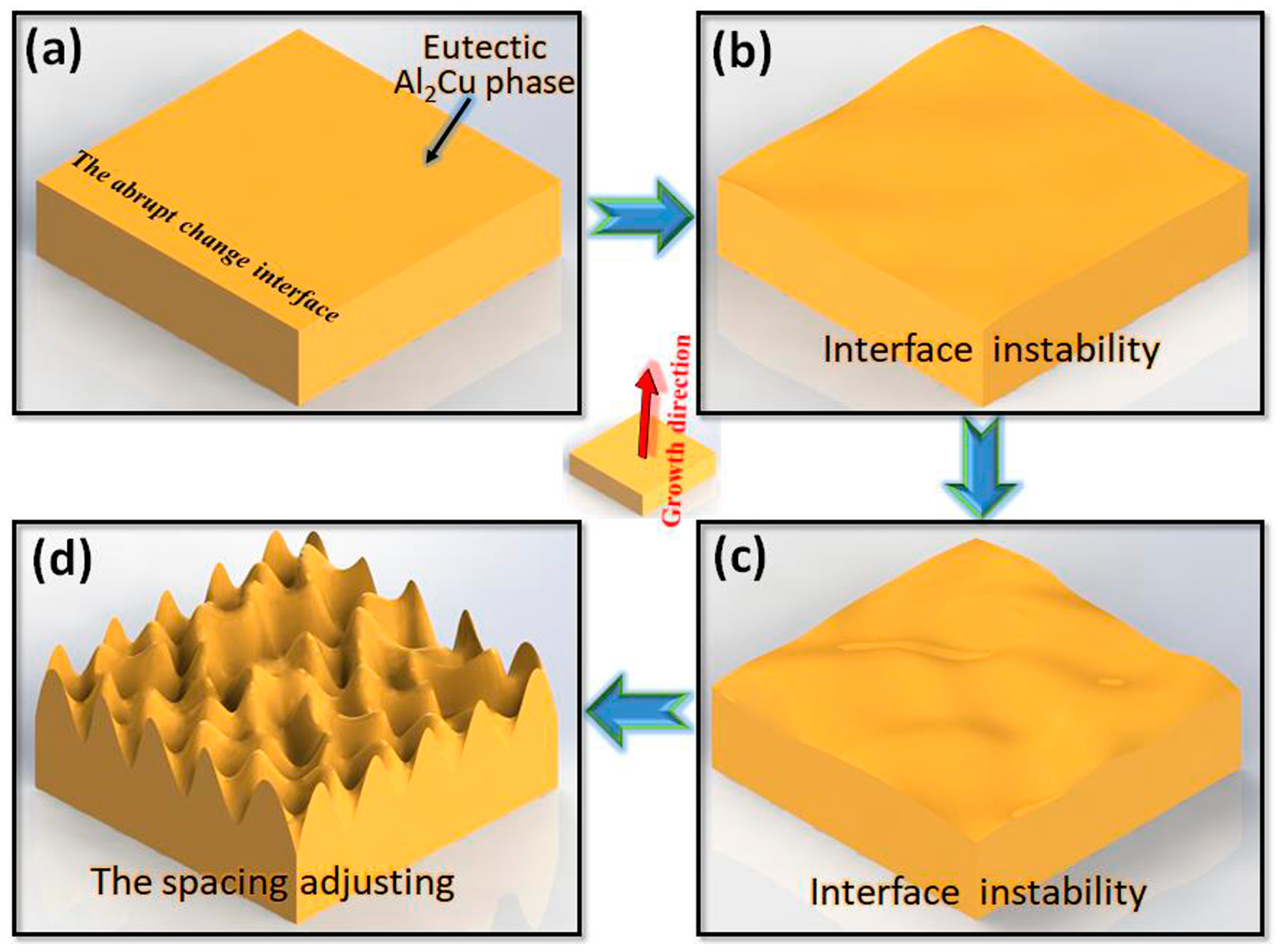
© 2020 by the authors. Licensee MDPI, Basel, Switzerland. This article is an open access article distributed under the terms and conditions of the Creative Commons Attribution (CC BY) license (http://creativecommons.org/licenses/by/4.0/).
Share and Cite
Gao, K.; Zhang, Z.; Zhao, J.; Sun, D.; Wang, F. Orientation and Microstructure Evolution of Al-Al2Cu Regular Eutectic Lamellar Bifurcating in an Abruptly Changing Velocity under Directional Solidification. Materials 2020, 13, 1004. https://doi.org/10.3390/ma13041004
Gao K, Zhang Z, Zhao J, Sun D, Wang F. Orientation and Microstructure Evolution of Al-Al2Cu Regular Eutectic Lamellar Bifurcating in an Abruptly Changing Velocity under Directional Solidification. Materials. 2020; 13(4):1004. https://doi.org/10.3390/ma13041004
Chicago/Turabian StyleGao, Ka, Zan Zhang, Junliang Zhao, Dejian Sun, and Fu Wang. 2020. "Orientation and Microstructure Evolution of Al-Al2Cu Regular Eutectic Lamellar Bifurcating in an Abruptly Changing Velocity under Directional Solidification" Materials 13, no. 4: 1004. https://doi.org/10.3390/ma13041004
APA StyleGao, K., Zhang, Z., Zhao, J., Sun, D., & Wang, F. (2020). Orientation and Microstructure Evolution of Al-Al2Cu Regular Eutectic Lamellar Bifurcating in an Abruptly Changing Velocity under Directional Solidification. Materials, 13(4), 1004. https://doi.org/10.3390/ma13041004




